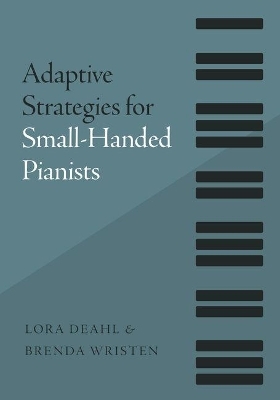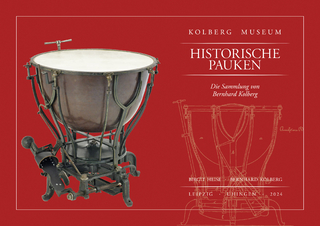
Adaptive Strategies for Small-Handed Pianists
Oxford University Press Inc (Verlag)
978-0-19-061684-7 (ISBN)
Adaptive Strategies for Small-Handed Pianists brings together information from biomechanics, ergonomics, physics, anatomy, medicine, and piano pedagogy to focus on the subject of small-handedness. The first comprehensive study of its kind, the book opens with an overview of historical, anatomical, and pedagogical perspectives and redresses long-held biases concerning those who struggle at the piano because of issues with hand size. A discussion of work efficiency, the human anatomy, and the constraints of physics serves as the theoretical basis for a focused analysis of healthy movement and piano technique as they relate to small-handedness. Separate chapters deal with specific alternative approaches: redistribution, refingering, strategies to maximize reach and power, and musical solutions for technical problems. Richly illustrated with hundreds of examples from a wide range of piano repertoire, the book is an incomparable resource for piano teachers and students, written in language that is accessible to a broad audience. It balances scholastic rigor with practical experience in the field to demonstrate that the unique physical and musical needs of the small-handed can be addressed in sensitive and appropriate ways.
Lora Deahl is Professor of Piano and Keyboard Literature and Associate Dean of Curricular and Undergraduate Issues at the Talkington College of Visual and Performing Arts at Texas Tech University. She is recognized for her solo and chamber performances throughout the U.S., Asia, and Latin America as well as pedagogical and scholarly articles in international and national journals of music. Recipient of the Chancellor's Council Teaching Award from Texas Tech University and the Outstanding Collegiate Teacher Award from the Texas Music Teachers Association, her students hold teaching positions around the world. Brenda Wristen is Associate Professor of Piano and Piano Pedagogy at the University of Nebraska-Lincoln. She is recognized for her research on the biomechanics of piano technique and varied aspects of musician health, and has published in numerous journals in the fields of piano pedagogy, music education, and performing arts medicine. She is a frequent presenter at international and national professional meetings.
Foreword
Acknowledgments
Key to Abbreviations and Graphic Symbols
Chapter 1: Understanding Small-Handedness
Defining the Small Hand
1 Demographics of Small-Handedness
1 The Evolution of the Modern Piano and Its Relationship to Small-Handedness
2 Historical Background
2 Ergonomically-Scaled (Reduced-Size) Piano Keyboards
1 Pedagogical Misconceptions About Small Hands
2 Selection Bias and Other Gender-Related Aspects
2 Attempts to Stretch the Small Hand
1 Small-Handedness and Injury
1 The Role of the Teacher
1 Conclusion
1 Reflection Points
Chapter 2: Fundamental Principles of Movement and the Playing Apparatus
1 Principles of Work Efficiency
1 Principles of Movement
2 Leverage
2 Newton's Laws and Piano Technique
2 Muscular Contraction and Release
2 Additional Characteristics of Movement Economy
2 Planes of Motion
2 Neutral Position at the Piano
1 The Parts of the Playing Apparatus
2 Torso
2 Shoulder and Upper Arm
2 Forearm
2 Wrist
2 Hand and Fingers
1 Conclusion
1 Reflection Points
Chapter 3: Technique and the Small-Handed Pianist
1 Maladaptive Tendencies
2 Fatigue
2 Power
2 Reach
1 Lexicon of Fundamental Facilitative Techniques for the Small-Handed Pianist
2 Avoiding Fatigue
3 Timing Muscular Releases
3 Using Levers Appropriately
3 Cultivating Finger-To-Elbow Alignment
3 Combining Basic Movements into Larger Gestures
3 Reducing the Amplitude of Movements and Gestures
2 Producing Power
3 Maximizing Key Speed
3 Transmitting Force Through Skeletal Structures
3 Using Arm Impulses
2 Addressing Large Reaches and Distances
3 Using the Arm to Navigate Distances
3 Using Passive Spread
3 Using Vertical Spanning
1 Boundaries
1 Conclusion
1 Reflection Points
Chapter 4: Redistribution
1 Uncrossing Parts
1 Eliminating Stretches in Chords and Arpeggios
1 Facilitating Leaps or Hand Shifts
1 Increasing Accuracy, Power, and Control
1 Maintaining More Neutral Hand and Wrist Positions
1 Facilitating Trills and Tremolos
1 Maintaining Legato and Line
1 Projecting Harmony
1 Conclusion
1 Application Problems
Chapter 5: Refingering
1 Fingering and Hand Size
1 Encouraging Compact Hand Positions
2 Chords
2 Arpeggios, Broken Chords, and Melodic Intervals
2 Consecutive Double Notes and Octaves
2 Readjusting the Hand to a More Compact Shape
2 Playing Seconds with the Thumb Alone
2 Using Non-Consecutive Fingerings
2 Playing Trills
1 Repeating the Same Finger to Recover Space in the Hand
1 Optimizing Sound Production and Voicing
2 Repeated Use of the Fifth Finger and Thumb to Project Melodies
2 Aligning the Hand and Forearm in a Skeletal Position
1 Moving Longer Fingers over Shorter Fingers
1 Substituting the Thumb for Inner Fingers
1 Using Positional Fingerings to Achieve Maximum Speed
1 Substituting One Finger for Another on the Same Key
1 Retaking Released Notes Silently
1 Conclusion
1 Application Problems
Chapter 6: Maximizing Reach and Power
1 Covering Large Distances
2 Applications of Either Oval or Fan-Shaped Gestures
2 Applications of Oval Gestures
2 Applications of Fan-Shaped Gestures
1 Facilitating Large Reaches
2 Applications of Passive Spread
2 Applications of Vertical Spanning
2 Applications of Passive Spread in Conjunction with Vertical Spanning
1 Dividing or Rolling Chords
2 Consecutive and Non-Consecutive Divisions or Rolls
2 Simultaneous Divisions or Rolls
1 Releasing Notes
2 Releasing Notes in Chords and Multi-layered Textures
2 Releasing Notes in Melodic Intervals, Arpeggios, and Broken Chords
2 Releasing Notes in Broken Octaves
1 Using Rotation for Power
1 Taking Advantage of Skeletal Support
1 Playing Staccato Chords and Octaves
2 Repeated Chords and Octaves
2 Traveling Staccato Chords and Octaves
2 Legato Octaves
1 Grouping Notes into Larger Gestures
1 Omitting and Revising Notes
1 Conclusion
1 Application Problems
Chapter 7: Musical Solutions for Technical Problems
1 Legato
2 Legato in Widespread Cantabile Melodies and Arpeggiated Accompaniments
2 Legato in Octave and Double-Note Passages
1 Fortissimo Playing
1 Pedaling
2 Damper Pedal
2 Sostenuto Pedal
1 Voicing
1 Rhythmic Inflection, Tempo Modification, and Rubato
1 Gestural Shaping
1 Conclusion
1 Reflection Points
Chapter 8: Integration and Exploration
1 Diagnosis and Integration
1 Exploration
1 Closing Thoughts
Glossary of Terms
Bibliography
List of Activities
List of Examples
Lists of Figures
List of Tables
Index
| Erscheinungsdatum | 12.06.2018 |
|---|---|
| Zusatzinfo | 388 line, 19 halftone |
| Verlagsort | New York |
| Sprache | englisch |
| Maße | 257 x 183 mm |
| Gewicht | 703 g |
| Themenwelt | Kunst / Musik / Theater ► Musik ► Instrumentenkunde |
| Kunst / Musik / Theater ► Musik ► Musiktheorie / Musiklehre | |
| Schulbuch / Wörterbuch | |
| ISBN-10 | 0-19-061684-9 / 0190616849 |
| ISBN-13 | 978-0-19-061684-7 / 9780190616847 |
| Zustand | Neuware |
| Informationen gemäß Produktsicherheitsverordnung (GPSR) | |
| Haben Sie eine Frage zum Produkt? |
aus dem Bereich


